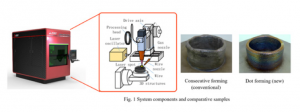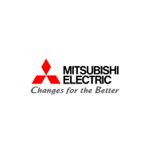Dot forming technology produces high quality 3D metal parts
Mitsubishi Electric Corporation has announced the development of a unique dot forming technology that delivers high-precision shaping by combining laser, computer numerical control (CNC) and computer aided manufacturing CAM technologies in 3D printers. Process Industry Forum explores this new technology.
Laser wire directed-energy deposition method
Mitsubishi’s technology produces high-quality three-dimensional (3D) parts with few voids at high speed, employing a laser wire directed-energy deposition (DED) method, which is an additive-manufacturing process that uses focused thermal energy to fuse materials as they are deposited. Mitsubishi Electric believes that its new technology will raise productivity in a wide range of applications, such as the “near-net” (near-final) shaping of aircraft and automobile parts and build-up repairs.
A three-dimensional metal shaping machine incorporating the new technology was due to be exhibited at the 29th Japan International Machine Tool Fair (JIMTOF2018), held at the Tokyo Big Sight exhibition complex at the beginning of November. Mitsubishi Electric expects to launch a commercial version within the year ending in March 2021.
Dot forming eliminates need for jigs and assemblies
Amid increasing demands for low-volume production, 3D shaping technology is being used to manufacture metal parts, especially for aircraft and automobiles, because the technology eliminates cost-bearing needs for jigs and assemblies and improves design freedom. The global market for 3D metal shaping equipment is expected to come of age.
Mitsubishi’s dot forming technology produces high-quality 3D parts with few voids, which can be formed at high speed using the laser wire DED method. This supplies metal wire directly to the laser-irradiated part for build-up shaping. As such, a variety of 3D shapes are possible, including hollow or overhanging shapes. The technology can also be combined with parts produced by other manufacturing methods and is therefore effective in build-up repairs.

60% better shape accuracy
Conventional 3D metal modelling equipment employs the powder bed fusion (PBF) method, in which stacked layers of thin metal powders are fused and bonded by a laser. Although PBF can form detailed, complicated shapes with high precision, modelling takes time and voids tend to form inside the shaped objects. The laser wire DED method, on the other hand, offers the advantage of forming dense objects at high speed. Furthermore, common, proven and inexpensive laser-welding wire can be used.
Mitsubishi’s unique technique repeats spot forming by synchronously controlling the pulsed laser irradiation, the supply of metal wires and shield gas, and the shaping position. Shape accuracy is 60% more precise compared to conventional consecutive forming technology. Oxidation, a problem with the conventional technology, can also be reduced by more than 20% compared to regular methods because high temperature area are limited to a narrow spot forming area.
For more information visit www.mitsubishielectric.com.
Get the latest process industry news
Interested in receiving even more industry-leading news from Process Industry Forum delivered directly to your inbox? Then sign up to our free newsletter. Bringing you the latest news, trends, innovations and opinion from across the process industry, our exclusive newsletter gives you all the industry insights of the moment in one, easy-to-digest bulletin. Stay ahead of the competition with regular process industry news instalments from PIF.

